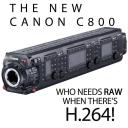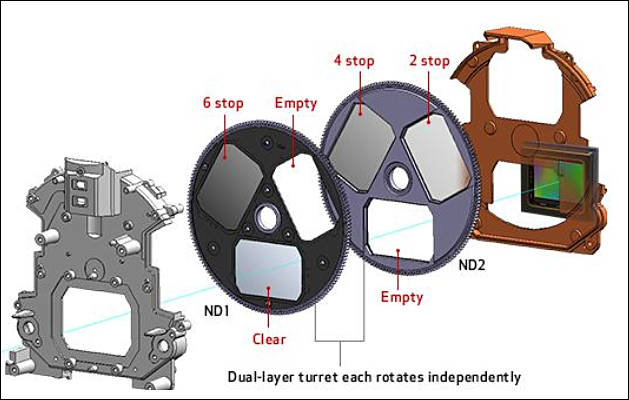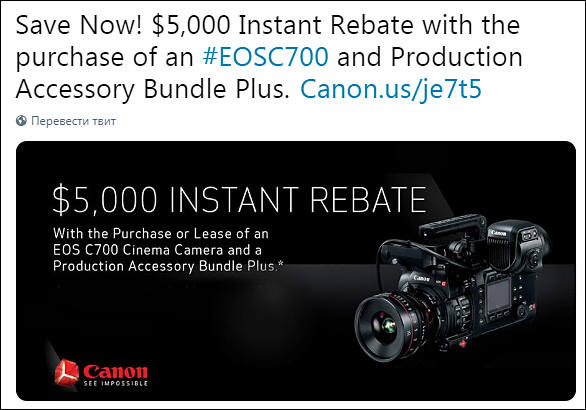
It allows to keep PV going, with more focus towards AI, but keeping be one of the few truly independent places.
-
- Super 35mm CMOS Sensor
- Breech-Lock PL Mount
- Up to 15 Stops of Dynamic Range
- 4K up to 60 fps, 2K/HD up to 240 fps at up to 810Mbps
- Proxy Recording to SD Cards
- Selectable Gamma and Log Curves
- XF-AVC and ProRes Recording to CFast 2.0
- Intuitive User Interface
- Raw Recording Option
- Internal 10/12-bit XF-AVC or ProRes recording
- 3 versions, one with global shutter
- $28000 at https://www.bhphotovideo.com/c/product/1278096-REG/canon_1454c002_eos_c700_cinema_camera.html
-
Canon today unveils two new flagship models in the esteemed Cinema EOS system – the EOS C700 (EF/PL) and EOS C700 GS PL. Both models are ready for the 4K generation, enabling high-end production houses and broadcasters to intuitively and easily shoot with a wide dynamic range, in supreme quality. The EOS C700 cameras capture creative slow motion 4K video footage internally with high frame rates of up to 59.94P/50P and 2K up to 200p/240p (sensor crop mode), or 4K RAW up to 100P/120P, to the optional dockable Codex[1] RAW recorder. Building on the Cinema EOS System range, the powerful video cameras are modular in design to adapt to all shooting requirements and include support for the Apple ProRes format for the first time. Designed for fast-moving subjects and action scenes, the EOS C700 GS PL is also the first Cinema EOS camera with a global shutter.
Quality and versatility for every production
Created with cinematographers and high-end broadcast production professionals in mind, both models deliver the versatility that the industry demands using a Canon Super 35mm CMOS sensor with a maximum pixel count of 4.5K (EOS C700 GS PL at 4.2K). 4K DCI or 4K UHD can be recorded up to an incredible 810Mbps. Combining the sensor with triple DIGIC DV5 processors, documentary makers can capture natural history and compelling stories in incredible detail, delivering spectacular high-resolution videos with low-noise and shallow depth of field. Together, with a high ISO of up to 102,400 and built-in ND filters, with up to 10-stops of control, both models offer enhanced flexibility and stunning cinematic detail, in even the most challenging of lighting conditions.
The EOS C700 EF’s Dual Pixel CMOS AF is incredibly effective at locking onto and tracking a subject allowing the camera operator to concentrate on framing the shot, making it easier for news reporters to film accurately on the move. Operators on drama productions will appreciate the acclaimed Dual Pixel Focus Guide feature, which is ideal for greater control and accuracy. Supporting Canon Log 3, Log 2 and Log Gammas, the EOS C700 (EF/PL) is capable of recording up to an incredible 15-stops of Dynamic Range (14-stops with the EOS C700 GS PL), where footage can be graded with greater confidence and flexibility in HDR post-production workflows.
Professional workflow integration
The EOS C700 (EF/PL) provides a wide range of colour space options, including the Canon Cinema Gamut, BT.2020, and DCI-P3, as well as support for ACES 1.0 workflow. The camera also supports HDR monitoring with SMPTE ST.2084. For a truly integrated, efficient and reliable HDR workflow, all versions of the EOS C700 can connect directly to the new DP-V2420, Canon’s 4K high luminance reference monitor that is able to support the new ITU-R BT.2100 standard for HDR output.
Offering universal appeal for high-resolution production, the EOS C700 is capable of recording high bitrate 4K files internally to dual CFast 2.0™, supporting both XF-AVC and ProRes formats, while simultaneously recording 4K RAW files to an external recorder. Equipped with an Ethernet (RJ45) terminal, the EOS C700 allows broadcasters to live stream Full HD footage via the internet, and also can be connected to a wireless network using the optional wireless file transmitter (WFT-E6B/WFT-E8).
To complement this powerful new camera, Canon has worked with Codex to provide a fully-integrated recording and workflow solution. The combination of the dockable Codex RAW recorder (CDX-36150) with the Canon EOS C700 allows for high-speed 4K RAW recording at up to 120 frames per second (fps). Future firmware upgrades[2] will include 4.5K RAW recording at up to 100 fps, 4K Apple ProRes at up to 60 fps, and Apple 2K ProRes at up to120 fps. Codex’s production-proven recording media - Codex Capture Drives - are used for both RAW and higher-speed ProRes recording. Along with the images, frame-accurate metadata such as lens information can also be captured, streamlining production and post-production processes and delivering time and money savings.
Build the camera your own way
The camera can be adapted to suit the needs of the individual as well as for each filming scene. For full customisation, there is an extensive range of optional accessories including a new 0.7’’OLED viewfinder system, the EVF-V70, which offers Full HD resolution (1920 x 1080) with a wide colour gamut. The optional Remote Operational Unit OU-700 can also be used to control the camera when shooting with a multi-member team. For newsgatherers and high-end documentary makers, a bespoke Shoulder Support Unit, the SU-15, and new Shoulder Style Grip Unit, the SG-1, will be available for on-the-move shooting.
For complete creative freedom and choice, anamorphic lenses are supported, along with a huge range of EF and PL lenses, plus the ability to use compatible Canon broadcast lenses with the optional B4 mount adapters (in Full HD mode). The EOS C700 with EF mount with Cinema Lock and EOS C700 PL with Cook/i support can even swap mounts by Canon service, if user requirements change
-
they are quite late for the party. 30k. Wow - they are aiming at? Amira? Varicam?
-
The full package will probably be a lot more. Canon is going for high margins at the top of the professional market, where convenience and time saved is a big deal.
-
maybe but there is a throne which is occupied by ARRI for years now. I don't see a reason why a producer will pick the Canon over the Amira at the same rental price.
-
The camera is direct competition for the Arri Amira, Varicam 35/LT and Sony F55. All of these cameras are now well established and already entrenched in the market.
The problem I have with the C700 isn’t with the camera itself, it is with the timing. It’s like Canon engineers got in a DeLorean and went back to the future. The camera would have been a great option two to three years ago, but it really doesn’t offer anything that substantial over its current competition (the Sony F55 was announced in 2012, the Arri Amira in 2013 and the Varicam 35 in 2014). I really think Canon missed the boat here as they had a prime opportunity to introduce something “different” that would have made the camera really stand out. Why not introduce a full-frame multi-aspect sensor? Canon has the ability to do it, and it would have set the C700 apart from its competition. Sure, there is a lot to like about the C700, but there is nothing there for me that differentiates it enough from its rivals.
Sums it up well. I think we'll see hefty discounts for the C700 in a year-ish, like with the C300mk2.

 14196202_1290469460985667_6138423041233182103_o.jpg1046 x 1046 - 86K
14196202_1290469460985667_6138423041233182103_o.jpg1046 x 1046 - 86K -
The C700 is modular. The rugged magnesium body is similar in size to another popular camera and about half the weight (approximately 7.9 lb for the EOS C700 PL and EOS C700 GS PL Main Body). The styling is distinctly Canon. Rounded edges and semi-circular sides behind the lens mount hint at the Canon C300 design legacy. Whereas the C300 has a medium format heritage, the C700 will be equally comfortable handheld, shoulder-resting, on a head, Steadicam, gimbal rig or rigged to a car mount.
There are enough 3/8-16 and 1/4-20 threaded holes on the top and bottom to satisfy the most demanding cheese-plate and accessory obsessed camera crew. The top handle attaches with two screws in a plethora of positions for perfect balance. Focus tape hooks adorn both left and right sides. Clearly, the designers at Canon listened to the requests of camera crews.
The shoulder pad consists of two sections that adjust to fit the width of any camera operator’s shoulder. It has industry-standard Hirth tooth rosettes on each side and sockets with 15mm rods in front. The camera comes with a standard rear V-lock battery mount. An Anton Bauer Gold Mount adapter could be used, but may not send battery status information to the camera’s EVF.
Check FDTimes on C700 - http://www.fdtimes.com/wp-content/uploads/2016/08/77-78_FDTimes-CanonC700.pdf
-
IF you take it apart there is an Eos M5 running Tizen.
-
Why not be able to apply both the 6 stop and 4 stop ND at once?
-
Quite pricey. Can be popular in rental. But who knows.
-
The one thing that separates this camera from all the other professional cameras, to me, is an autofocus that works. At least most of the time as reported by Geoff Boyle (cinematography.net). These days, all too often I find myself pulling my own focus. Either the budget is too low for me to bring on an experienced AC, or production provides an AC- where my first question is- “Can you pull focus?” The typical reply is “I know how to pull focus.” where-in I let them start pulling focus and eventually I just pull my own focus. Knowing how to pull focus and pulling focus are two different matters entirely. With my aging eyes, while I’m panning and tilting and composing the frame, I just can’t tell if something is in focus. Peaking on many cameras has a delay- and low contrast shots it doesn’t work at all. I’m usually pulling focus by instinct, not by marks or by monitoring. I’ve been lucky but it is nerve-racking and I’m usually all sweaty after a small shoot. A camera with a working autofocus- along with a good focus puller- would make the day go faster. Because a good focus puller does more than keep the subject in focus. A talented focus puller has a great feel for reaching a subject at the right moment. With few, or no rehearsals at all these days (default or stylistic choice) someone focusing on focus with an artistic sense is a great asset to production. And our daily shot counts will go up with a working focus system. And a talented focus puller can jump in and pull focus manually on a moments notice. I think it’s the future and I welcome it. Now to find autofocus lenses that I like…
-
Usage primer
-
Overview
-
Firmware Version 1.0.1.1.00:
- Adds the following new recording modes: 4.5K RAW and Apple ProRes in CDX-36150
- RAW Format
- Media: Capture Drive 2.0 (Resolution / Max. Frame Rate)
- [4.5K] 4512×2376 / 100 fps
- [4.5K Cinescope] 4512×1920 / 120 fps
- [2K Crop] 2048×1080 / 240 fps- ProRes Format*2
- Media: Capture Drive 2.0 (Resolution / Codec / Max. Frame Rate)
- 4096×2160 / ProRes 422 HQ / 60 fps
- 3846×2160 / ProRes 422 HQ / 60 fps
- 2048×1080 / ProRes 422 HQ / 120 fps
- 2048×1080 / ProRes 4444 XQ / 60 fps
- 2048×1080 / ProRes 4444 / 60 fps
- 1920×1080 / ProRes 422 HQ / 120 fps
- 1920×1080 / ProRes 4444 XQ / 60 fps
- 1920×1080 / ProRes 4444 / 60 fps
- 2048×1080 (Crop) / ProRes 422 HQ / 240 fps
- 1920×1080 (Crop) / ProRes 422 HQ / 240 fps
- Allows CDX-36150 firmware to be updated through the camera menu. *3
- Fixes communications with the Remote Controller RC-V100.
- Adds the following new recording modes: 4.5K RAW and Apple ProRes in CDX-36150
-
Firmware fix
We have determined that an error in recording may occur for the EOS C700, EOS C700 PL, and EOS C700 GS PL.
The details of the phenomenon and support plan are described below.
Phenomenon
Footage may be corrupted due to the following conditions.
When the main recording format is set to ProRes (either with CFast or using the Codex Capture Drive*1) and the output recording command is set to [On], a recording error may occur if the recording stops due to the “Media full” message. Then the “Some clips require data recovery” message appears. Even after performing recovery, a message saying “Unable to recover data” appears. The final clip cannot be recovered.
Please note that this will only affect the last recorded clip on the media. If the media doesn’t become full, this phenomenon will not occur.
Howdy, Stranger!
It looks like you're new here. If you want to get involved, click one of these buttons!
Categories
- Topics List23,993
- Blog5,725
- General and News1,354
- Hacks and Patches1,153
- ↳ Top Settings33
- ↳ Beginners256
- ↳ Archives402
- ↳ Hacks News and Development56
- Cameras2,368
- ↳ Panasonic995
- ↳ Canon118
- ↳ Sony156
- ↳ Nikon96
- ↳ Pentax and Samsung70
- ↳ Olympus and Fujifilm102
- ↳ Compacts and Camcorders300
- ↳ Smartphones for video97
- ↳ Pro Video Cameras191
- ↳ BlackMagic and other raw cameras116
- Skill1,960
- ↳ Business and distribution66
- ↳ Preparation, scripts and legal38
- ↳ Art149
- ↳ Import, Convert, Exporting291
- ↳ Editors191
- ↳ Effects and stunts115
- ↳ Color grading197
- ↳ Sound and Music280
- ↳ Lighting96
- ↳ Software and storage tips266
- Gear5,420
- ↳ Filters, Adapters, Matte boxes344
- ↳ Lenses1,582
- ↳ Follow focus and gears93
- ↳ Sound499
- ↳ Lighting gear314
- ↳ Camera movement230
- ↳ Gimbals and copters302
- ↳ Rigs and related stuff273
- ↳ Power solutions83
- ↳ Monitors and viewfinders340
- ↳ Tripods and fluid heads139
- ↳ Storage286
- ↳ Computers and studio gear560
- ↳ VR and 3D248
- Showcase1,859
- Marketplace2,834
- Offtopic1,320











